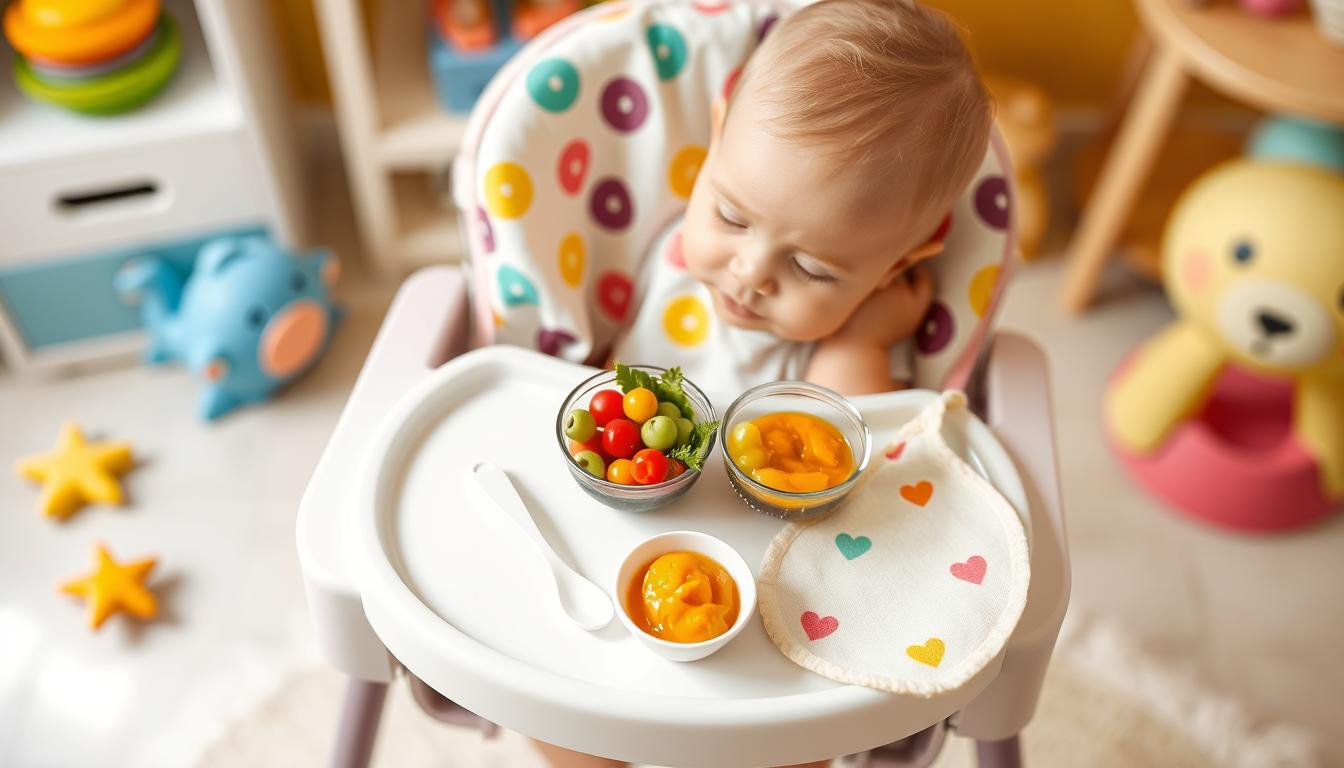Starting solid foods for your baby. Wondering when and how to start solid foods with your baby? It’s a big step, but don’t worry. This guide will help you through it. We‘ll cover everything you need to know for a smooth start.
Table of Contents
ToggleKey Takeaways
- Breastmilk or formula should be the primary source of nutrition for babies under 6 months.
- Most babies are ready to start solids around 6 months of age, when they show signs of developmental readiness.
- Introduce new foods one at a time and watch for any allergic reactions.
- Gradually transition from purees to mashed and finger foods as your baby grows.
- Avoid choking hazards and unhealthy foods like honey, juice, and raw vegetables.
When to Start Solid Foods
Starting solid foods is a big step for your baby. But figuring out when is the right time can be hard. The American Academy of Pediatrics (AAP) says to start around 6 months. Yet, every baby is different.
Before starting solids, look for signs of readiness. Also, follow age guidelines for a smooth transition.
Signs of Readiness
Babies usually show they’re ready for solids between 4 and 6 months. Look for these signs:
- Ability to sit upright and hold their head steady
- Increased interest in food and reaching for what you’re eating
- Loss of the tongue-thrust reflex, where they push food out of their mouth
Age Guidelines
The AAP suggests starting solids around 6 months. But most babies are ready between 5 and 6 months. Experts warn against starting too early, as it may lead to allergies and health problems.
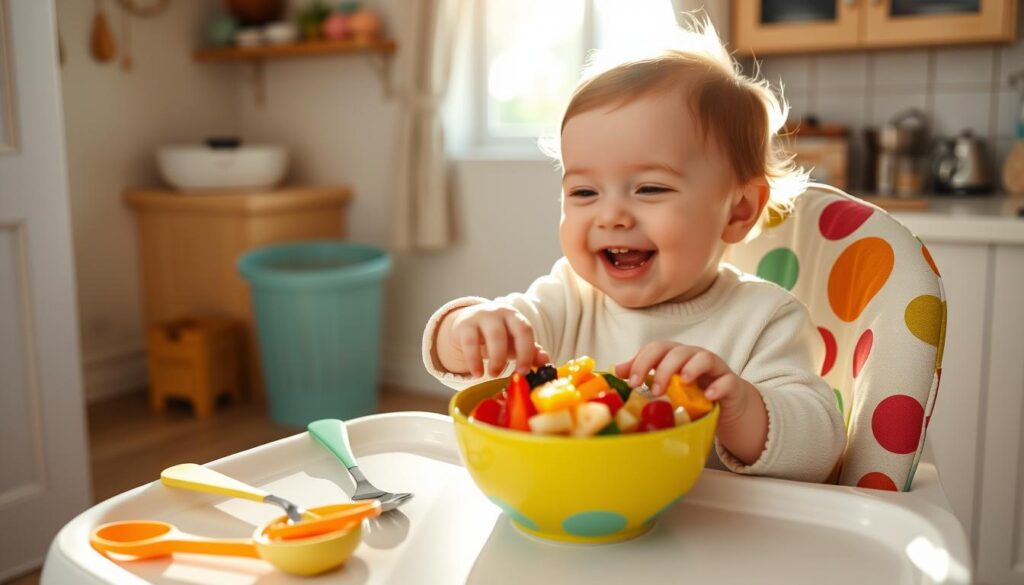
“Healthy babies typically do not require additional water besides breastmilk or formula, but small amounts of water can be offered when solid foods are introduced.”
Deciding when to start solids should be a team effort. Talk to your pediatrician. They can guide you based on your baby’s growth and needs.
First Foods for Infants
The American Academy of Pediatrics (AAP) suggests starting with iron-fortified infant cereals like oat, barley, or multi-grain. These cereals are packed with iron, which is vital for your baby’s growth.
Begin by mixing a small amount of cereal with breast milk or formula. Make it smooth and thin. As your baby gets used to it, you can make it thicker. This helps your baby’s stomach adjust to solid foods.
Iron-Fortified Baby Cereals
Iron-fortified baby cereals are a top pick for best first foods for babies. They’re rich in iron and easy for babies to digest. This makes them perfect for introducing solids to infants.
- Oat cereal
- Barley cereal
- Multi-grain cereal
Starting with these best first foods for babies ensures your baby gets the nutrients they need. This is key for their growth and development.
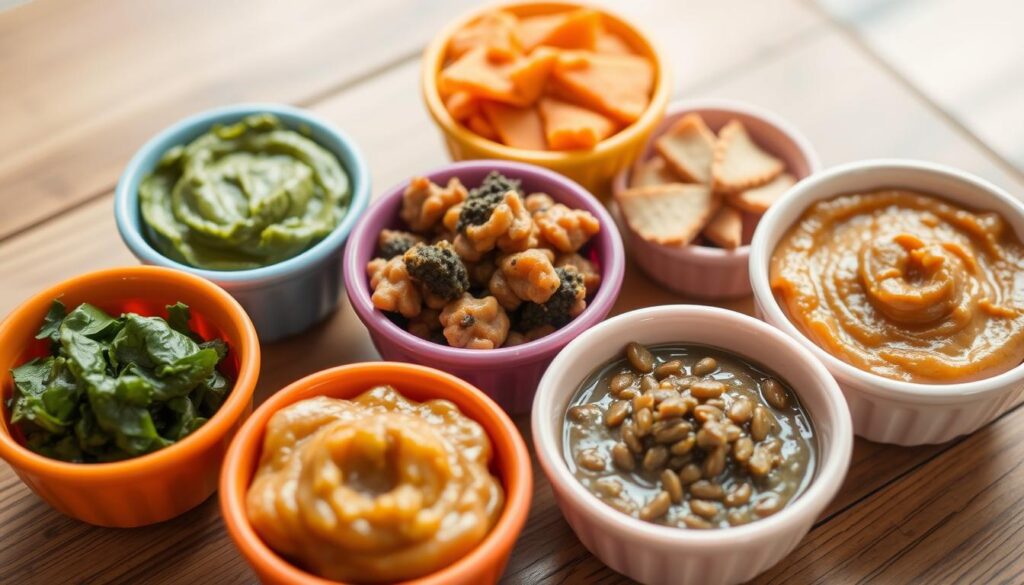
“Introducing solid foods is an exciting milestone, but it’s important to do it at the right time and in the right way for your baby’s health and development.”
| Nutrient | Importance for Baby |
|---|---|
| Iron | Crucial for healthy blood, brain development, and immune function |
| Zinc | Supports a healthy immune system and cell growth |
| Vitamin B6 | Helps convert food into energy and supports brain development |
Introducing New Foods
Introducing new solid foods to your baby needs patience and careful planning. The American Academy of Pediatrics (AAP) suggests introducing one new food at a time. Wait 3-5 days before trying another food. This helps watch for any allergic reactions or sensitivities.
One Food at a Time
Start introducing new foods to babies around 4 to 6 months. Pediatrician Rachel Dawkins recommends starting with infant oatmeal mixed with breastmilk or formula. Then, introduce stage one foods like pureed avocados, peas, squash, banana, or apples.
Offer these foods daily for three days to check for any bad reactions. Babies might need 10-12 tries to like new tastes. So, be patient and keep trying.
Allergenic Foods
The AAP also says to introduce foods that might cause allergies, like peanuts, eggs, and dairy, when introducing other foods. Early exposure might help prevent food allergies. But, if your baby has severe eczema or a known food allergy, talk to your pediatrician first.
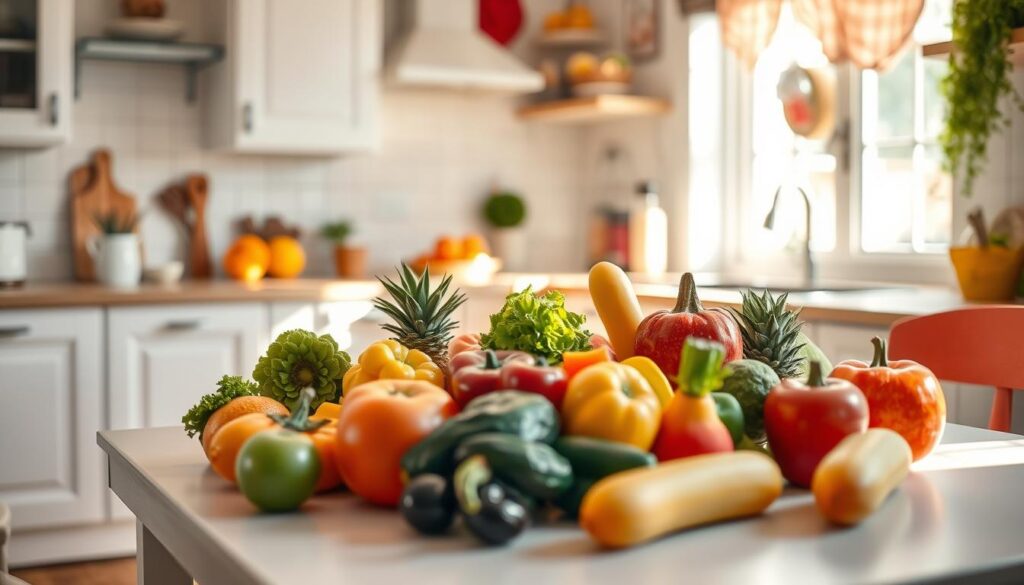
At around 9 months, babies can start with finger foods like meats and small fruits and veggies. Avoid foods that could cause choking, like grapes (unless cut into quarters), hot dogs, nuts, raw veggies, fruit chunks, and popcorn. Water in a sippy cup can be given to babies around 9 months to 1 year during meals and snacks.
Remember, introducing foods one at a time and being patient with your baby’s taste preferences are key. This helps with a smooth transition to solid foods and can prevent food allergies.
Preparing Baby Food
Starting your baby on solid foods is exciting. It’s key to watch the textures you offer. At first, foods should be smooth and easy to swallow. Then, they can get thicker and softer.
This helps your baby learn to eat and enjoy different foods. It’s a big step in their growth.
Smooth and Runny
Begin with fruits and veggies that are smooth and runny. Meats should be ground or shredded finely. Don’t add salt, sugar, or spices yet.
The goal is to make sure your baby’s food is easy on their stomach. It’s their first taste of solid foods.
Thicker Purees and Chunkier Textures
When your baby gets better at eating, you can try thicker foods. This step is towards eating with their fingers. Make fruits, veggies, and meats a bit thicker.
Every baby is different. Watch how they react to new foods. Change the textures to keep them happy and healthy.
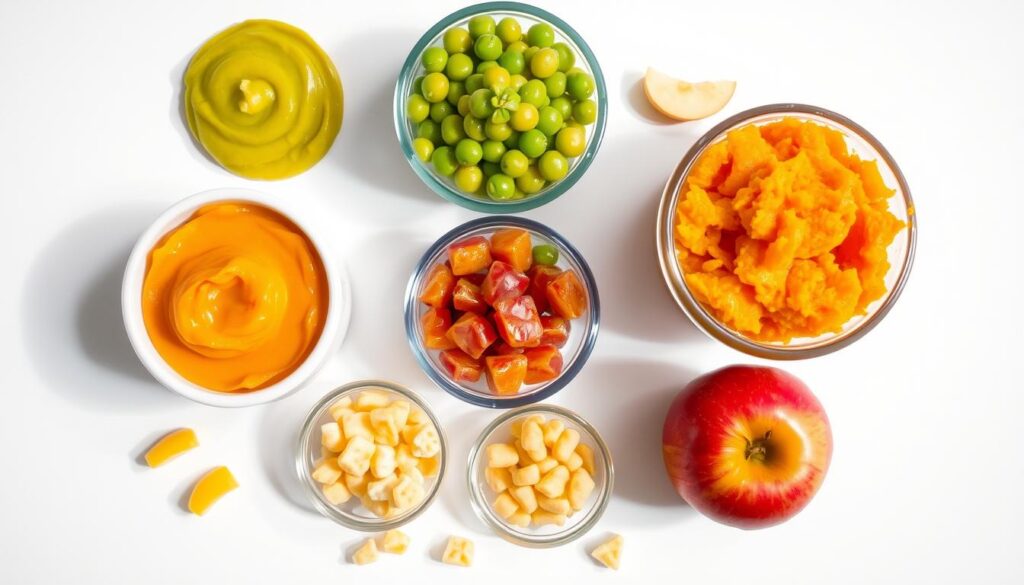
“The key to successful baby food preparation is paying close attention to your child’s developmental stage and adjusting the textures accordingly.”
Choosing the right textures helps your baby love food. It sets them up for good eating habits later on.
Starting Solid Foods for your baby
Starting solid foods is a big step in your baby’s life. It’s a time of change and growth. You need to watch for signs that your baby is ready and listen to their cues.
Most babies start with solids around 6 months. They should be able to sit up and show interest in food. But, wait until they are at least 4 months old to start.
Begin with iron-fortified cereals to help with iron levels. Then, add pureed fruits, veggies, and proteins. Start with one new food at a time to watch for any issues.
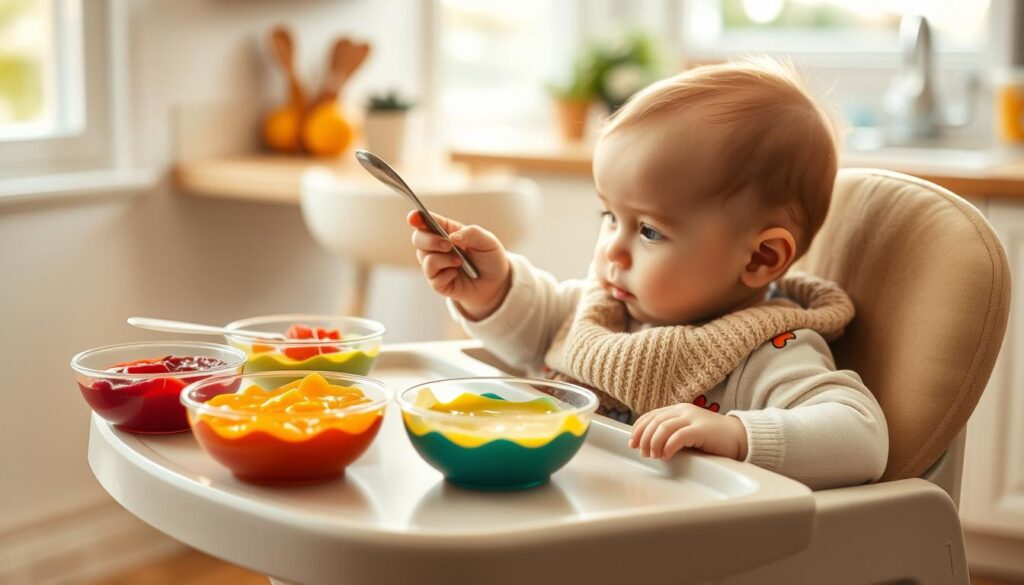
As your baby gets better at eating, you can give them more textured foods. This helps with chewing and talking. Remember, breastmilk or formula should still be the main food until they are at least 12 months old.
Starting solid foods is a fun adventure for you and your baby. Listen to their signs, start small, and introduce foods one at a time. This way, you’ll help them grow strong and healthy.
Feeding Schedule and Portions
As your baby starts eating solid foods, it’s key to have a regular feeding schedule. Here’s a guide for ages 6 to 12 months:
6 to 9 months: Give your baby 2-3 meals a day. Each meal should have 2-4 tablespoons of solid food. Still, breast milk or formula should be their main food.
9 to 12 months: Move to 3-4 meals a day. Each meal should be the size of your baby’s fist. Solid foods should be a bigger part of their diet, but breast milk or formula should still be the main source.
| Age | Milk Intake | Solid Food Intake |
|---|---|---|
| 4-6 months | 24-36 ounces per day | 1-4 tablespoons of cereal, fruit, and vegetables per day |
| 6-8 months | 24-36 ounces per day | 4-9 tablespoons of cereal, fruit, vegetables, and protein per day |
| 9-12 months | 16-30 ounces per day | 1/4 to 1/2 cup of grains, fruits, vegetables, dairy, and protein per day |
Remember, these are just general guidelines. Your baby’s needs might be different. Always talk to your pediatrician for advice on feeding schedule and portion sizes.
Finger Foods and Self-Feeding
When your baby is 8-9 months old, they might be ready for soft, easy-to-swallow foods. They should be able to sit up on their own and reach for things. This is a great time to start with finger foods and help them learn to feed themselves.
Safe Finger Foods
Choose soft, small pieces of food, like a pea. Good options include:
- Ripe, cubed banana
- Cooked, soft sweet potato pieces
- Well-cooked, soft pasta
- Shredded chicken or ground meat
- Soft, cubed tofu
- Oatmeal, cooked and cooled
Stay away from foods that could be choking hazards, like grapes or hot dogs. Always watch your baby while they eat. Cut food into small pieces. Offering different finger foods for babies helps them try new tastes and textures.
As your baby gets better at self-feeding for babies, they might eat more solid foods. They might drink less milk. This is okay as they learn to do things on their own and enjoy safe finger foods for infants.
“Finger foods are a great way to encourage your baby’s self-feeding and help them develop important motor skills.”
Foods to Avoid
Starting your baby on solid foods is exciting. But, it’s key to know which foods to avoid. These foods can be choking hazards or have harmful ingredients.
Honey is a no-go for babies under 12 months. It can cause botulism, a serious condition. Cow’s milk isn’t good as a main drink either. It doesn’t have the right nutrients for your baby’s growth.
Stay away from foods that could choke your baby, like nuts, seeds, raisins, and popcorn. Also, don’t add salt or sugar to their food. Their bodies can’t handle these ingredients yet.
| Foods to Avoid | Potential Risks |
|---|---|
| Honey | Risk of botulism in infants under 12 months |
| Cow’s milk as a primary beverage | Lacks necessary nutrients for infant growth and development |
| Nuts, seeds, raisins, popcorn | Choking hazards |
| Added salt and sugar | Underdeveloped kidneys and no nutritional value |
Knowing which foods to avoid helps keep your baby safe and healthy. This is the start of their solid food journey.
“The first years of a child’s life are critical for developing healthy eating habits. By avoiding certain foods and focusing on nutritious options, you’re setting your baby up for long-term success.”
Tips for Successful Mealtimes
Mealtimes with a baby can be tough, but a regular routine makes it better. Start by making a calm space, washing your baby’s hands, and sitting them down. Also, keep a feeding schedule and let your baby explore and feed themselves. This helps make mealtime easier with baby.
Creating a Routine
Being consistent is crucial for creating a feeding routine for baby. Stick to a regular mealtime schedule so your baby knows when to eat. Turn off the TV and toys to keep mealtimes stress-free with infant. Let your baby use their hands to explore food, which boosts their fine motor and thinking skills.
Be patient and listen to your baby’s needs. Every baby is different, and they might take time to adjust to new foods and mealtime. Keep going, and you’ll find a routine that fits your family well.
FAQ
What are the signs that my baby is ready to start solid foods?
Signs include sitting upright, good head control, and interest in food. Losing the tongue-thrust reflex is also a sign. Most babies are ready between 5 and 6 months.
When is the best time to introduce solid foods to my baby?
The American Academy of Pediatrics (AAP) suggests starting around 6 months. But, the right time varies for each baby. Introducing solids before 4 months can raise allergy and health risks.
What are the best first foods for my baby?
The AAP suggests starting with iron-fortified infant cereals like oat, barley, or multi-grain. These provide essential nutrients like iron, important for development.
How should I introduce new solid foods to my baby?
Introduce new foods one at a time, waiting 3-5 days between each. This helps spot allergic reactions. The AAP also recommends introducing common allergens like peanuts and eggs early.
What are the best textures and consistencies for my baby’s first solid foods?
Start with smooth foods that are easy to swallow. Gradually move to thicker purees and then soft pieces. Cook fruits and veggies until smooth. Meat should be finely ground or shredded.
How should I establish a feeding schedule and portion sizes for my baby?
Offer 2-3 meals a day, each 2-4 tablespoons, from 6 to 9 months. Increase to 3-4 meals a day, with fist-sized portions, from 9 to 12 months. Always prioritize breast milk or formula as the main nutrition source.
What are some safe and appropriate finger foods for my baby?
Introduce soft finger foods when your baby can sit up and feed themselves. Try small banana pieces, cooked sweet potato, and soft chicken. Avoid foods like grapes and raw veggies that can be choking hazards.
What foods should I avoid giving my baby during the first year?
Avoid honey, cow’s milk as a main drink, and hard foods like nuts and seeds. Also, don’t add salt or sugar to their food.
How can I make mealtimes with my baby more successful?
Create a calm environment, wash hands, and sit down to eat. Stick to a schedule and let your baby explore food. Be patient and watch for their cues as they learn.

